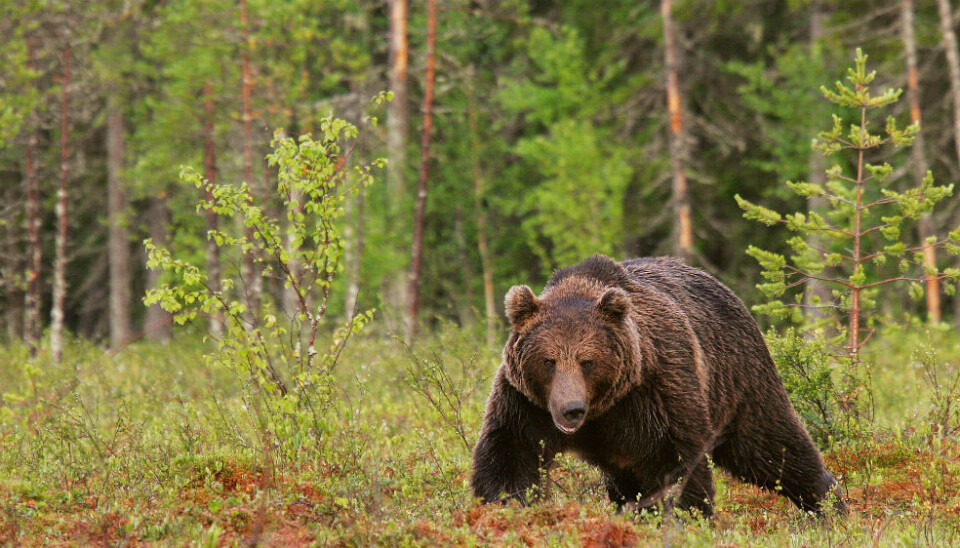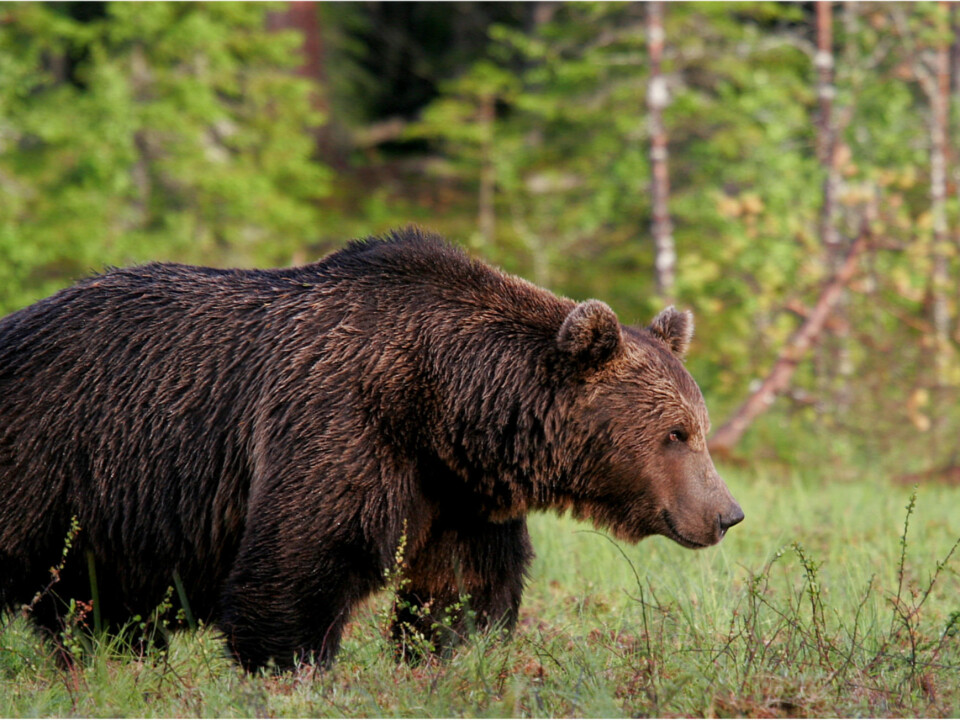This article was produced and financed by Norwegian Institute for Agricultural and Environmental Research

Limited gene flow among brown bears in Northern Europe
The estimation of gene flow points to a connectivity of the bears between Southern Finland and Western Russia, while migration between Scandinavia and Northern Finland appears to be limited.
Denne artikkelen er over ti år gammel og kan inneholde utdatert informasjon.
Brown bears have been near extinction for centuries. In recent years, however, the number of bears has increased, especially in Northern and Eastern Europe.
To find out whether or not the recovery of the Northern European brown bear population is a result of migration from Russia, researchers have carried out an extensive study involving genotyping of bears in Finland, and compared their genetic composition to bears from Russian Karelia, Sweden and Norway.
Two genetic clusters
Their investigation has identified two overlapping genetic clusters.
One cluster includes Russian bears, and migration analyses show a high number of migrants from Russia into Finland.

"This provides evidence that eastern gene flow has had a say in the recovery of the bear population in this area,” says Dr. Alexander Kopatz from the Norwegian Institute for Agricultural and Environmental Research (Bioforsk). He has recently published an article on the topic as part of his PhD.
Clusters exclude bears from Sweden and Norway
As well as identifying two genetic clusters, Kopatz and his fellow researchers have discovered that both clusters exclude bears from Sweden and Norway. They did not find any migrants from Finland in these countries either.
According to Kopatz, this indicates that eastern gene flow has probably not been important for the recovery of the bear population in Scandinavia.
“Our analyses on different spatial scales suggest a continuous bear population in Finland and Russian Karelia, which is completely separated from Scandinavia,” Kopatz says.
High gene flow between Finland and Russian Karelia
The Finnish bear population is located centrally between the Russian and Scandinavian bear populations.
The researchers analysed data from a total of 517 bears from 2006 to 2010, which included 286 samples from individuals from Finland, collected annually from legally harvested bears.
To investigate the gene flow from Russia into Finland and westwards to Scandinavia, the researchers included previously genotyped individuals from Norway, Sweden and Russia.
“By covering all possible migration routes and applying continuous sampling corresponding to the estimated distribution of bears in the area, we discovered that the brown bear population in
Finland and Russian Karelia consists of two clusters, a northern and a southern one,” Kopatz says.
“The clusters showed substantial geographical overlap and the genetic differentiation between them was modest, suggesting a high degree of admixture.”
“Our migration analyses supported these findings and showed that gene flow between Finland and Russian Karelia was high, especially in the east-west direction,” says Kopatz.
In comparison, gene flow between Finland and Scandinavia appeared to be restricted, and was found to be absent from the east towards Scandinavia
Unexpected genetic overlap between clusters
The researchers had not expected to find such a substantial degree of overlap between the two clusters of the Finnish brown bear population.
“It may be possible that the two clusters were once a single population,” Kopatz says.
“Another possibility is that both populations were connected better in the past and may have been divided during the period of persecution.”
According to historical records, the brown bear was virtually extinct from most parts of Finland, with exception of the areas south-east and in the north, near the border to Russia.
During the time of extensive persecution the number of individuals plummeted and the population may have become subdivided.
“The demographic recovery may have connected the clusters again. If that is the case, the genetic differentiation between the two populations was probably never high,” Kopatz explains.
Limited connectivity between Finnish/Russian and Scandinavian bears
In their study, the researchers found the connectivity of the Finnish and Russian Karelian brown bears with populations in the west towards Scandinavia to be more restricted.
All detected first generation migrants in Northern Finland were identified as individuals originating from the Scandinavian population, which migrated towards east, into Finland.
The Scandinavian bear population, however, has its main distribution in Sweden with outliers into Norway.
“The Finnish bear population is the only connection of the Scandinavian bear population to the Russian one,” says Kopatz.
Although the Finnish and the Scandinavian populations both started off their recovery from being hunted down to near extinction in most parts, their mechanisms of recovery must have been quite different. This is reflected in today’s genetic composition.
“Our results show that the Finnish population has probably always experienced gene flow from Russia in comparison to the Scandinavian bear population, which recovered without substantial support from other populations,” Kopatz says.
"Although the Scandinavian bear population does not suffer from inbreeding, the situation revealed in this study is analogue to the situation of wolves in Sweden, which are isolated from other populations," he adds.
Future studies
As far as further research goes, Kopatz suggests that historical samples should be analysed to shed light on the history of brown bears in the Northern and Eastern regions.
“We propose that future studies should analyse historical samples to elucidate the history of the brown bears in Finland, Russian Karelia and Scandinavia during the time of persecution and initial phases of recovery,” Kopatz suggests.
“Also, analyses on recent migration should be monitored and focus more intensively on bears in different regions by applying noninvasive genetic sampling and estimation of capture-mark-recapture probabilities.”
“This can result in feasible estimations on possible demographical changes, such as reproduction and turn-over rates as well as the ratio between effective and census population sizes,” he says.






























